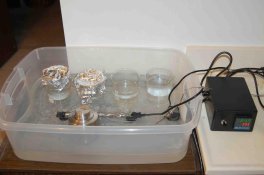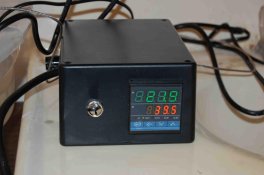warrennn
Member
I have noticed a certain amount of interest in temperature stabilizing a water bath at 38C for use in the processing of color film. I did a very exhaustive search a while ago and found that many people were interested in modifying an aquarium heater for this purpose, with some limited success. I have come up with a different solution to the problem and would like to impart it to anyone who is interested.
My approach was inspired by a web site describing a homebrew sous vide cooking bath using cheap readily available parts: http://seattlefoodgeek.com/2010/02/diy-sous-vide-heating-immersion-circulator-for-about-75/. I slightly modified the approach described in this article.
The heart of the unit is a digital PID temperature controller (model CD101) which is readily available on ebay - mine cost $28. The controller samples the temperature from a thermocouple or RTD (resistive temperature detector - basically a thermistor) and supplies an on/off signal to an internal or external relay which controls a heater. The signal is massaged to obtain the optimum correction to minimize the temperature error and improve the response to external temperature changes.
I use a plastic storage container for the bath whose volume is about 3 gallons. The developing tank and the mixed chemicals are placed in the bath - the latter in glass beakers in my setup. The sensor in my system is a platinum RTD (model PT100) in a sealed stainless steel tube - mine cost $6 on ebay. RTDs are preferred over thermocouples since the response is absolute, rather than the difference between two junctions in a thermocouple. The most expensive component was the 110 VAC heater, which is a 250 Watt titanium aquarium heater and cost $38. To keep the bath at a uniform temperature, I used an inexpensive aquarium pump, which works very well and cost $9 on the famous auction site.
With no tweaking, the unit immediately stabilized the bath temperature with an error of less than +/-0.1C (after a warm-up of about 1.5 hours). The controller unit I received used an internal relay, whose maximum current is 3 A (my heater needs about 2 A). This was adequate for my bath, though a 500 W heater would have been better (it would need the unit which powers an external relay). The relay clicks on and off: the on time is 10 seconds and the off time is about 5 seconds. A more powerful heater could equalize those times. (By the way, the ebay descriptions give little information on whether or not there is an internal relay - one should ask the vendor for this information). Using two identical BD oral digital fever thermometers, I verified that the maximum difference between the temperature at any two points in the bath is 0.1C.
One of the problems I had was that the temperature of the solutions in the beakers was 3F less than that in the bath. This was reduced to about 1.5F when I covered the beaker with aluminum foil. My (possibly crude) solution was to raise the bath temp. by about 1.5C (above 38C). I did some "dry runs" of the developing procedure using water and found that the temps were generally within the +/-0.3C for the first developer and certainly within the +/-1C for the color developer.
I have yet to try this on real film and will report my progress when I do. Feel free to ask questions or make suggestions.
Warren Nagourney
My approach was inspired by a web site describing a homebrew sous vide cooking bath using cheap readily available parts: http://seattlefoodgeek.com/2010/02/diy-sous-vide-heating-immersion-circulator-for-about-75/. I slightly modified the approach described in this article.
The heart of the unit is a digital PID temperature controller (model CD101) which is readily available on ebay - mine cost $28. The controller samples the temperature from a thermocouple or RTD (resistive temperature detector - basically a thermistor) and supplies an on/off signal to an internal or external relay which controls a heater. The signal is massaged to obtain the optimum correction to minimize the temperature error and improve the response to external temperature changes.
I use a plastic storage container for the bath whose volume is about 3 gallons. The developing tank and the mixed chemicals are placed in the bath - the latter in glass beakers in my setup. The sensor in my system is a platinum RTD (model PT100) in a sealed stainless steel tube - mine cost $6 on ebay. RTDs are preferred over thermocouples since the response is absolute, rather than the difference between two junctions in a thermocouple. The most expensive component was the 110 VAC heater, which is a 250 Watt titanium aquarium heater and cost $38. To keep the bath at a uniform temperature, I used an inexpensive aquarium pump, which works very well and cost $9 on the famous auction site.
With no tweaking, the unit immediately stabilized the bath temperature with an error of less than +/-0.1C (after a warm-up of about 1.5 hours). The controller unit I received used an internal relay, whose maximum current is 3 A (my heater needs about 2 A). This was adequate for my bath, though a 500 W heater would have been better (it would need the unit which powers an external relay). The relay clicks on and off: the on time is 10 seconds and the off time is about 5 seconds. A more powerful heater could equalize those times. (By the way, the ebay descriptions give little information on whether or not there is an internal relay - one should ask the vendor for this information). Using two identical BD oral digital fever thermometers, I verified that the maximum difference between the temperature at any two points in the bath is 0.1C.
One of the problems I had was that the temperature of the solutions in the beakers was 3F less than that in the bath. This was reduced to about 1.5F when I covered the beaker with aluminum foil. My (possibly crude) solution was to raise the bath temp. by about 1.5C (above 38C). I did some "dry runs" of the developing procedure using water and found that the temps were generally within the +/-0.3C for the first developer and certainly within the +/-1C for the color developer.
I have yet to try this on real film and will report my progress when I do. Feel free to ask questions or make suggestions.
Warren Nagourney










 . Make sure they're the type-316 s.s. tanks, not a more inferior quality.
. Make sure they're the type-316 s.s. tanks, not a more inferior quality.

